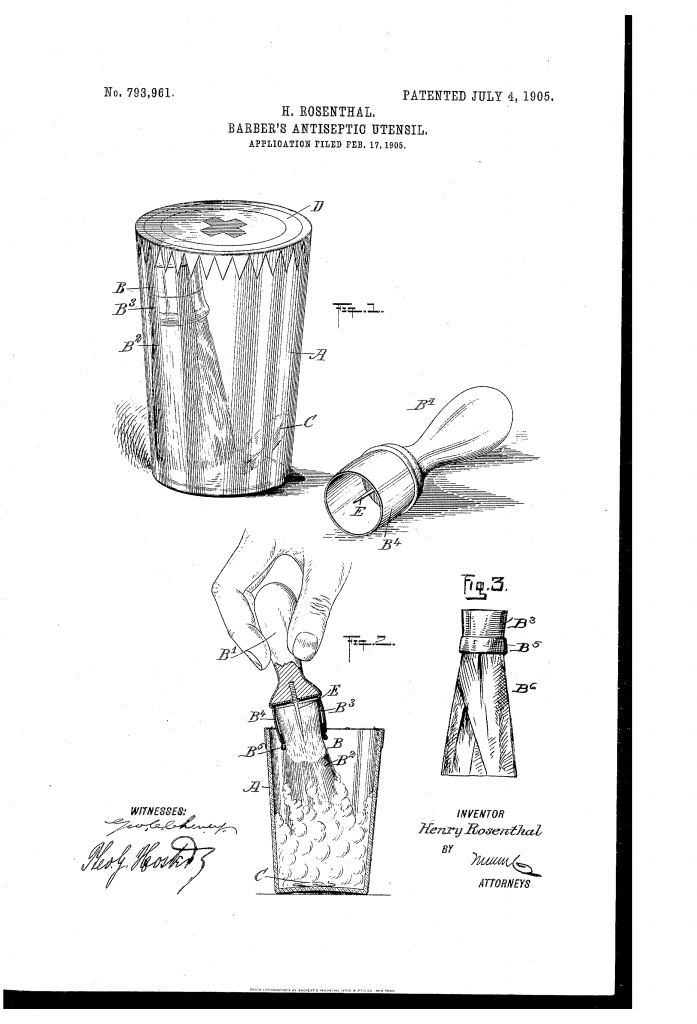When you go to a barbershop, you want the tools used to be clean. In the days before antibiotics, you really wanted the tools used to be clean. Which is why there are so many patent for antiseptic utensils for barbers. From simple disposable cups, via more complete outfits, to shiny glass and brass contraptions. What sets Henry Rosenthal’s antiseptic utensil apart from the others is that he filed his patent before the big shaving brush anthrax scare.
Henry also did one better than many inventors by not using a paper cup. And he did one worse to himself when it came to the brush… More on that later.
But first, let us see what he was trying to achieve:
The invention relates to barbers supplies; and its object is to provide a new and improved barbers antiseptic utensil, insuring to the person to be shaved at a barber-shop the use of an antiseptic shaving-cup, an antiseptic brush, and antiseptic soap.
From US patent 793,961
A noble goal. And one Henry sought to achieve not just by an invention, but by setting up a whole supply chain.

On first glance, it is fairly straight forward. A sanitized and sealed glass. In the glass, a small piece of antiseptic soap, and a sanitized brush knot set in a metal ferule. The knot could be wrapped in paper, as shown in figure 3, to make sure the barber didn’t get finger funk all over it. Although I would hope the barber would have clean hands, so… I don’t think the paper wrap would be all that critical.
To use, the barber would break the paper seal, and stab the knot with the reusable handle. Note the spike in the handle that would help secure the knot. The barber would then add a little water and lather up the antiseptic soap inside the antiseptic utensil. The spike and the shape of the ferule would hold the knot securely, so it wouldn’t fling across the room if the barber got a little too energetic.
So far, so good. But a glass cup wasn’t really a disposable item in 1905, and there is no indication in the patent that Henry intended to make the knot disposable either. So clearly something had to be done to stop the barber ruining himself by buying the antiseptic utensils… and that something is spelled out in the patent text.
It is understood that the supply-house on the return of the used cup and brush-body resterilizes both…
From US patent 793,961
So Henry wasn’t just going to sell antiseptic utensils. He seemingly wanted to set up a system where he would supply the antiseptic utensil, for a fee, He would then take the used antiseptic utensils back, clean them, repackage, and reseal… and then resell them. For a fee, obviously. He could keep reselling the same cup and knot to barbers over and over again.
But wait, you may say, how do you sanitize a brush knot? Well, that is where genius may slide over into insanity. Let us read the rest of the paragraph I quoted above:
…and in doing so it is desirable to disconnect the bunch of bristles from the ferrule to allow of spreading the bristles during the washing and sterilizing process. After washing and sterilizing the bristles they are again bunched and placed back into the ferrule without the use of cement or like binding substance.
From US patent 793,961
So each time the brush came back it would be taken apart, the hairs cleaned and the brush reassembled. And while I don’t doubt that this would be doable, per se, it would be a slow and labour intensive process. And that would drive the cost up, possible to the point where it would not be worth the ordeal.
Perhaps Henry ought to have considered making his brush from fibrous materials or paper?
As it is, I have no idea of Henry ever got into making his sanitary, recyclable antiseptic utensils for barbers. But his patent remains, and you can be read it at Google Patents.

Pingback: Barber's antiseptic utensil - Razors n Blades the shave that saves